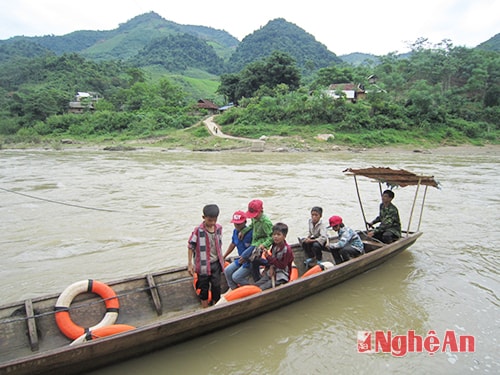The story of crossing the river in Liu Tien
(Baognhean) - We returned to Luu Tien village, Chieu Luu commune (Ky Son) on a day at the beginning of the rainy season. The Nam Mo river, which is usually quite gentle, began to flow turbulently. From National Highway 7A, the only way to get to Luu Tien is by boat. The boat in Luu Tien is also very strange, completely different from the boats in the lowlands...
(Baognhean) - We returned to Luu Tien village, Chieu Luu commune (Ky Son) on a day at the beginning of the rainy season. The Nam Mo river, which is usually quite gentle, began to flow turbulently. From National Highway 7A, the only way to get to Luu Tien is by boat. The boat in Luu Tien is also very strange, completely different from the boats in the lowlands...
Luu Tien village is only separated from National Highway 7A by the Nam Mo River, but the journey back and forth is difficult to describe. Before the historic flash flood in 2011, Khe Tang suspension bridge had not been washed away, making travel easy and convenient. Since the bridge was washed away, Luu Tien villagers have begun to enter difficult and arduous days every time they have to leave the village. The main means of transportation is a wooden boat (about 8 people can sit), anchored by a cable strung across the two banks. The boat is attached to the cable by a pulley and a very long rope. Unlike regular boats that are controlled by oars, motorboats are controlled by a steering wheel, the boat in Luu Tien is controlled by... a rope! The speed, fast or slow, does not depend on the driver's will, but on the speed of the river. That means the boat moves thanks to the force of the water flow, the role of the driver is to keep balance, avoid the risk of water flooding the boat, and not let the boat capsize.
 |
| The boat rocked in the middle of the Nam Mo River. |
We had to go to Luu Tien, although we were very reluctant, we still had to get on the boat, there was no other way. The boat docked at the shore, the passengers got on and felt dizzy. When passing through the strong current, the boat suddenly swayed and rocked, everyone could not help but feel... heart-stopping. The river water rose high and flowed strongly so the boat glided very fast, in a moment we had reached the other side. The local passengers all seemed normal, and as for the passengers from the lowlands like us, we all breathed a sigh of relief.
Luu Tien is located far from the commune center, home to nearly 150 households of the Khmu ethnic group. People here live mainly by slash-and-burn farming and raising livestock, and their lives are still difficult and arduous. Many households still suffer from hunger all year round. The houses in Luu Tien are still small, and the roads are still muddy in the rainy season. Talking to us, the village chief Cut Van Tien said: “Our village still faces many difficulties, especially in traveling. On days when the water is high, the village is isolated. There is no bridge, and during flood season, boating is very dangerous, and transporting goods for sale is also very difficult and expensive. The most worrying thing is that the junior high school students have to go to school in the commune center, crossing the river at least twice a week.” According to preliminary statistics, this new school year, Luu Tien village has about 20 junior high school students. Most of them stay at school, going to school at the beginning of the week and returning on the weekend. Therefore, traveling during rainy and flood days is extremely dangerous for children.
Coming to Luu Tien, we noticed something quite special, which is the "warehouses" for storing motorbikes and bicycles. Also originating from the distance of the river ferry, the small boat mentioned above can only be used to carry people, not vehicles, so the people here thought of a way to build "warehouses". These are small houses, roofed with cement corrugated iron, made of planks, built near the ferry dock, on the side of National Highway 7A to store bicycles and motorbikes. About 10 families share a "warehouse" like this. That means they cannot bring their motorbikes home, so when they arrive at the ferry dock, the people of Luu Tien unlock the "warehouse" to store their motorbikes, and when they need to take them away, they come back to unlock them. It is worth mentioning that the motorbikes are kept in the "warehouse", quite far from the residential area, and far from the river and the ferry, without worrying about theft. Because the people here are always conscious of helping each other to preserve and protect their property, there are often people taking turns guarding them. Teachers who come to teach at Luu Tien school or visitors from other places all park their vehicles near the ferry terminal and there is always someone to "keep an eye" on them.
Leading us to the location of the unfinished suspension bridge, Village Chief Tien shared: “The old bridge was swept away by the flood, the State invested in building a new bridge, at first the people were very happy. But after more than 2 years of construction, the bridge pier is still not finished, and the contractor has not continued construction for a long time. I hope this bridge will be completed soon, so that the people of Luu Tien can have less worries!”
Article and photos:Tuong Anh


